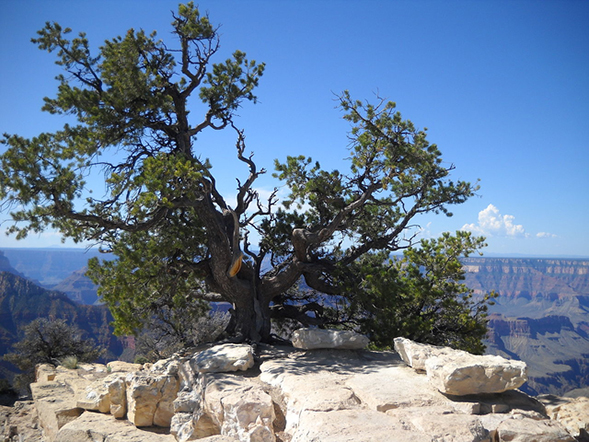Can Pinyon Pines Survive Climate Change?
A new study led by an SDSU biologist finds this critically important pine tree struggles to reproduce at higher temperatures.

Pinyon pines are an indispensable part of the American Southwest. Many Native American tribes relied upon the sustenance provided by their pine nuts—a harvest crop that remains economically important today. Woodland creatures depend upon the trees for shelter and as a food source.“They are a very important part of the ecosystem. They are a foundation species.”
So it’s critical for ecologists to understand how these trees will cope with warmer, drier conditions under climate change, according to San Diego State University evolutionary ecologist Lluvia Flores-Rentería. Findings from her recent studies suggest higher temperatures can interrupt the trees’ reproduction, which could reduce their numbers and even lead to localized extinctions in particularly warm areas.
These trees are no strangers to tough environments. They have adapted to thrive in lower-elevation, semi-arid conditions where other pines don’t grow. As a result, they form enormous open woodlands across drier, lower regions mostly in Arizona, Colorado, New Mexico and Utah. It’s the dominant pine in Colorado, making up 22 percent of the state’s forests.
“They are a very important part of the ecosystem,” said Flores-Rentería. “They are a foundation species.”
Pinyon pines are relatively slow growers. They reach maturity after about 20 years, but don’t produce female cones until they are some 40 years old. That slow life cycle means the trees can’t bounce back from die-offs due to drought or wildfire as quickly as some other species. As drier, warmer conditions are expected in the Southwest in the coming years, Flores-Rentería and colleagues from Northern Arizona University conducted experiments to learn how these trees might respond to climate change.
They collected pollen from 24 pinyon pines growing at elevations between 1,700 and 2,000 meters in Northern Arizona. Back at the lab, they grew the pollen in petri dishes at one of three temperatures: 30, 35 or 40 degrees Celsius (86, 95 or 104 degrees Fahrenheit). Then they observed the pollen to see if it would germinate, a critical step in plant reproduction in which pollen extend a tube which transmits genetic material to a flower or cone.
Regardless of the elevation, higher temperatures decreased the pollen’s viability dramatically. In some cases, trees’ pollen became totally unviable. These effects were more pronounced in pollen collected from lower and higher elevations, and less pronounced at middle elevations.
That suggests these pines may be unable to reproduce if temperatures rise even modestly. The researchers published their findings in the journal Frontiers in Plant Science.
“Four or five degrees may not sound like a big deal to humans, but it can be a really big deal for plants,” Flores-Rentería said. “And that kind of temperature increase is about what we expect to see in the future. Over the next 80 years or so, it’s possible that for trees experiencing heat waves during reproduction, the pollen simply won’t be able to germinate.”
According to some climate change models, that could mean the localized extinction of pinyon pines in certain areas. Yet Flores-Rentería’s other recent work offers a glimmer of optimism. A study she co-authored last year in Proceedings of the National Academy of Sciences found that certain varieties of pinyon pines have specific types of fungus that grow with them, and these fungi might confer some degree of drought tolerance.
Whether these drought-protective fungi might help lower-elevation pinyon pines to keep reproducing under warmer, drier conditions remains unknown, but their relationship underscores the importance of learning more about the complex biology at work in this critical species, Flores-Rentería said.
“Ultimately, we’re still learning what will be the fate of these trees under climate change.”



